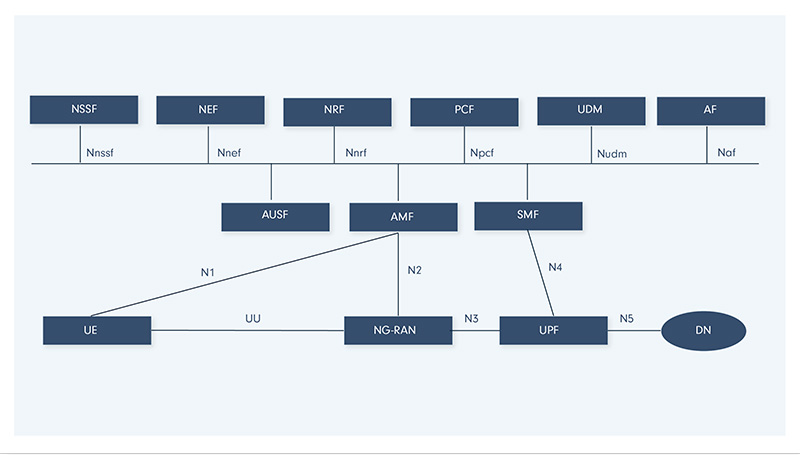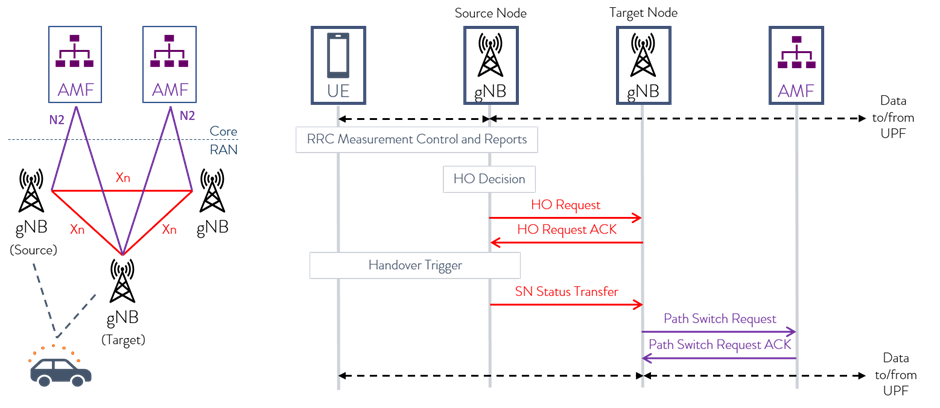
Exploring the 3GPP AMF – Access & Mobility Management Function
Exploring the 3GPP AMF – Access & Mobility Management Function
The Access & Mobility Management Function, or AMF, is a control plane function in the 5G core network that handles connection and management mobility tasks. As the AMF performs the role of access point to the 5G core, terminating RAN control plane and UE traffic originating on the N1 or N2 reference interfaces, it is responsible for NAS ciphering and integrity protection algorithms.
Mobility Management in the 5G SBA
Mobility management is a key function in any network, as it’s responsible for the tracking, registration, management, and authorisation of network connections – and access to subscribed services – as devices roam between base stations.
In LTE networks, the Mobility Management Entity (MME) controlled mobility management, but in the 5G Service-Based Architecture (SBA) that has been decomposed into the Access & Mobility Management Function (AMF), the Session Management Function (SMF) and the Unified Data Management (UDM) network function (NF), all of which supports the ongoing separation of control and data (user) plane traffic, begun when CUPS (Control and User Plane Separation) was introduced to the Evolved Packet Core (EPC).
By decoupling control signalling from user session traffic, a more distributed network architecture is enabled that provides massive scalability and flexibility, edge computing, and a more cost-effective approach to the 5G core network.
AMF is integral to this, as it coordinates network handovers between base stations allowing users to connect to the 5G network and access the services they are subscribed to as they move around. It also helps to manage the huge number of devices (including IoT) connected to the 5G network, such as logistics, connected vehicles, and so on.
In 5G, AMF terminates the control plane of different access networks onto the 5G Core Network (5GCN), and controls which UE (devices) can access the 5GCN and exchange traffic with Data Network (i.e., access subscribed services). As such, the AMF assumes control for mobility management and, where possible, manages roaming of UEs between gNodeBs (gNBs) in order to aid session continuity, as shown in Figure 1.
Figure 1 – 3GPP 5G Standalone service-based architecture

Source: Emblasoft
As a control plane function in the 5G core network, the main functions and responsibilities of AMF are:
- Registration Management;
- Reachability Management;
- Connection Management; and
- Mobility Management.
Registration Management
This allows UE to register and deregister with the 5G network. To gain authorisation to use 5G services, the UE must first complete an initial registration procedure. Following completion of the initial registration, the UE is moved from the RM-Deregistered state to the RM-Registered state, which creates a UE Context within the network.
Connection Management
This establishes and releases control plane signalling connections between the UE and the AMF across the N1 interface. The N1 signalling connection then moves the UE from CM-Idle to CM-Connected.
Reachability Management
In order to move to the CM-Connected state the UE first needs to be triggered. Reachability Management ensures that any UE is always reachable and available to be triggered whenever there is a need to establish a mobile-terminated connection. Paging the UE, which is in the CM-Idle state, triggers the UE to initiate the NAS Service request procedure and subsequently establish an N1 signalling connection before moving into the CM-Connected state.
Mobility Management
Any UE is required to maintain periodic registration updates following completion of the initial registration. Mobility Management maintains knowledge of the UE’s location within the network. These periodic updates verify that the UE remains on the network, has not moved out of coverage, or has not stopped working (for example, the UE is broken or out of battery). Updates are also triggered for mobility purposes when a UE moves outside its registration or tracking area.
The AMF is also responsible for managing handovers between gNBs within the Next-Generation RAN – this is known as an Xn handover in 5G, which is an updated reference interface application protocol (XnAP) employed between gNB base stations, as defined within the 3GPP’s TS 38.423.
Figure 2 – UE handover between source and target gNBs within 5G infrastructures

Source: Metaswitch
As data flows from the UE via a source gNB to the data plane of the 5G Core (the UPF), Radio Resource Control (RRC) signalling continuously measures and reports on signal quality. When the source node detects that a handover is required, it connects with the target gNB to commence the switching process. Once the data tunnels have been moved across to the target gNB, the UE performs a handover and connects to the same target node. A path switch request is made from the target gNB to the AMF and, once acknowledged, the data can flow from the UE through the target node and onto the appropriate UPF.
Other AMF Functions
The AMF also provides a number of other significant functions in the 5G network, as listed below:
- Next Generation Application Protocol;
- 5G Globally Unique Temporary Identifier (5G-GUTI);
- Selecting an Appropriate Authentication Server Function (AUSF);
- Selecting an Appropriate Unified Data Management (UDM);
- Selecting Appropriate Policy Control Function;
- Selecting an Appropriate Session Management Function (SMF);
- Single Network Slice Selection Assistance Information (S-NSSAI); and
- Support for Short Message Service (SMS).
Next Generation Application Protocol (NGAP)
AMF handles Next Generation Application Protocol (NGAP) signalling, which is transferred between the AMF and 5G RAN node (base station). NGAP specifications are described in 3GPP TS 38.413. Different categories of NGAP signalling procedures include:
- PDU Session Management;
- UE Context Management;
- UE Mobility Management;
- Paging Procedures;
- Transport of NAS messages;
- Interface Management;
- Configuration Transfer; and
- Warning Message Transmission.
5G Globally Unique Temporary Identifier (5G-GUTI)
The AMF allocates a 5G Globally Unique Temporary Identifier (5G-GUTI), which provides greater privacy than IMSI because it’s a temporary identity, which the AMF can re-assign at any time.
Selecting an Appropriate Authentication Server Function (AUSF)
AMF is responsible for selecting an appropriate AUSF during the registration procedure. The AUSF allows the UE to authenticate itself with the 5GCN. The AMF can use a specific AUSF or the Network Function Repository Function (NRF).
Selecting an Appropriate Unified Data Management (UDM)
AMF is responsible for selecting an appropriate Unified Data Management (UDM) function during the registration procedure. The UDM manages the user's subscription information. The AMF may be configured to use a specific UDM, or the AMF may use the Network Function Repository Function (NRF) to discover the UDM that manages the user's subscription.
Selecting Appropriate Policy Control Function (PCF)
The PCF provides the AMF with an 'Access and Mobility Policy' for the UE. This may include a specification of allowed or forbidden Tracking Areas. The AMF can be configured to use a specific PCF or the NRF to discover a PCF that can provide the relevant UE information.
Selecting an Appropriate Session Management Function (SMF)
AMF is responsible for selecting an appropriate Session Management Function (SMF) during PDU session establishment. AMF can apply a range of criteria during the selection procedure for Data Network Name (DNN). DNN refers to the data network to which PDU Session provides connectivity and is the 5G equivalent to 4G Access Point Name (APN).
Single Network Slice Selection Assistance Information (S-NSSAI)
An S-NSSAI identifies a network slice and comprises a Slice/Service Type (SST) and a Slice Differentiator (SD). The SST defines expected network behaviour.
Support for Short Message Service (SMS)
AMF provides support for Short Message Service (SMS). Mobile terminated SMS are received from SMS Function (SMSF) and packaged within a NAS message before being transferred to the UE. A signalling Radio Bearer (SRB) is used to transfer the NAS message across the air interface.
How do we help?
The AMF is an integral component of the 5GCN, enabling the management of Registration, Reachability, Connection, and Mobility of UE. The AMF also coordinates network handovers between base stations and provides essential security and authorisation capabilities.
Emblasoft Evolver provides full 3GPP interface support, enabling providers to model end-to-end network functions such as AMF, UPF, NRF, SMF, and PCF, as well as other nodes, with support for N1, N2, N3, N4, N6, N11 and other interfaces.
It allows the validation of mobility scenarios at load and scale, with automated test and active monitoring between AMF functions, end-to-end, enabling the delivery of quality roaming services.
Testing 3GPP N1 and N2 interfaces is an essential task, as they enable the connection from the UE to the network and AMF. To test service performance from the perspective of subscribers – connecting through the RAN to the core – requires support for N1 and N2.
Both N1 and N2 are included in the Evolver 5G test suite range, allowing effective emulation of test messages from emulated UE devices to be sent to the AMF.
In this configuration, Evolver acts as a gNB, so validation is an essential step toward service verification. As well as running individual test scenarios, Evolver, crucially, also enables mass testing, emulating millions of subscribers – and ensuring service performance under realistic load levels. Each test can be configured with different criteria enabling fine-grained modelling to ensure that realistic traffic representing real subscribers in the network is used to emulate real-world conditions.
Evolver enables the testing of end-to-end characteristics across the entire 5GCN. This allows operators to test the network before and during deployment and allows vendors to validate functionality before the launch of commercial offers.